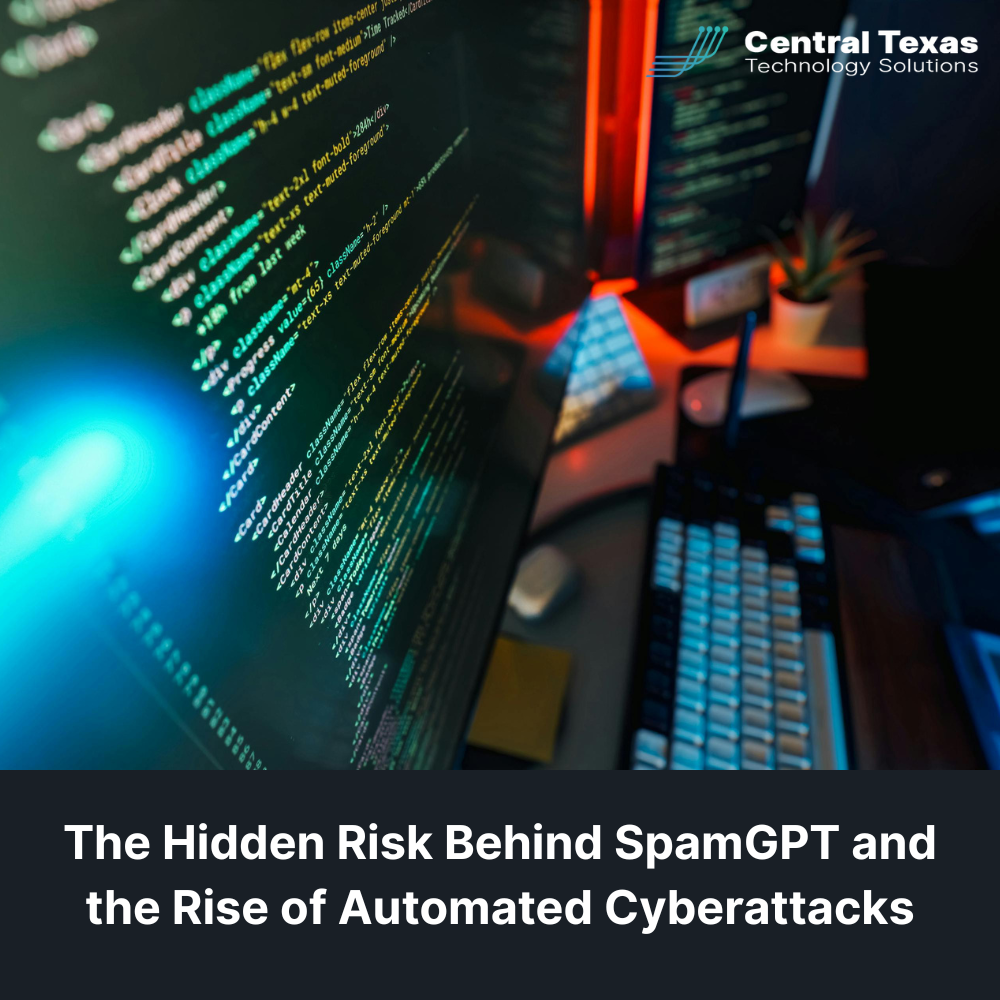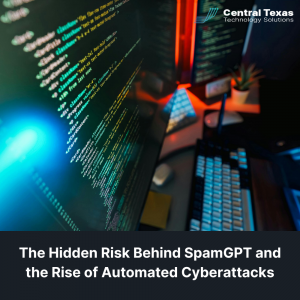
 Cyberattacks are becoming increasingly dangerous, sophisticated, and automated than ever before. Business leaders across Austin are already facing increased pressure to protect their organizations, but a new threat has escalated risk to a level we have never seen before. Security researchers have uncovered a powerful platform called SpamGPT, a tool that enables cybercriminals to create mass phishing campaigns with the same ease as your marketing team uses to send newsletters.
Cyberattacks are becoming increasingly dangerous, sophisticated, and automated than ever before. Business leaders across Austin are already facing increased pressure to protect their organizations, but a new threat has escalated risk to a level we have never seen before. Security researchers have uncovered a powerful platform called SpamGPT, a tool that enables cybercriminals to create mass phishing campaigns with the same ease as your marketing team uses to send newsletters.
SpamGPT is not a minor upgrade to traditional phishing tools. It represents a major shift in how criminal networks plan, launch, and scale their cyberattacks. Instead of relying on a small group of skilled hackers, cybercrime operations now have a system that allows almost anyone to run large-scale, AI-powered attacks. That puts every business at greater risk, especially fast-growing organizations in the Healthcare, Legal, Professional Services, Construction, Manufacturing, and Nonprofit Sectors.
CTTS helps Austin businesses stay ahead of these evolving threats by pairing proactive security strategies with local support that understands how real cyberattacks unfold.
Understanding SpamGPT and Why It Matters for Modern Cyberattacks
SpamGPT resembles familiar marketing software, but everything inside the system is designed for criminals. It mirrors dashboards from the platforms your team may already know, such as Mailchimp or HubSpot, but replaces legitimate tools with criminal automation.
The software gives attackers a menu of features that dramatically reduce the skill required to run cyberattacks at scale. Researchers found that SpamGPT offers:
- Prebuilt phishing templates that mimic real business communications
- Automated global scheduling so attackers can send thousands of messages at once
- Real-time analytics showing open rates, click rates, and engagement
- Simple editing tools that allow attackers to craft messages that appear polished and credible
SpamGPT is essentially an email marketing platform for cybercrime. This means attackers do not need advanced skills. They only need the ability to click buttons and follow simple prompts. The result is an explosion in mass cyberattacks that appear more authentic than anything employees have seen before.
Cyberattacks Are Becoming Easier and Faster to Launch
Traditional phishing required criminals to understand both the technical and human elements of deception. SpamGPT eliminates those barriers and automates the heavy lifting. Attackers can now launch cyberattacks with the same efficiency and scale as a marketing team performing a promotional blast.
The risks escalate because:
- Scale has increased. A single attacker can now send thousands of targeted messages almost instantly.
- Quality has improved. AI-generated content removes the spelling errors, grammar mistakes, and awkward phrasing that employees usually look for.
- Speed is unmatched. Automated systems can run continuously without human participation.
SpamGPT is helping criminals send phishing emails that look professional, match your internal communication style, and bypass basic security filters. This is why modern cyberattacks are becoming harder for employees to spot and harder for outdated defenses to block.
How Social Engineering Enhances These Automated Cyberattacks
SpamGPT becomes even more dangerous when paired with social engineering techniques. Attackers pull information from public records, online profiles, and stolen databases. They use this data to create highly believable emails that look like they were written inside your organization.
These emails might reference internal projects, use correct titles, mimic real signatures, and even match your typical communication timing. An employee might receive an email that appears to come from a department head or CFO, complete with the right tone and branding.
This level of accuracy makes cyberattacks more effective because victims are responding to messages that feel familiar and legitimate. Businesses in Austin are already reporting attempts that look like internal memos, financial approvals, or vendor updates.
What Business Leaders in Austin Can Do To Reduce Risk
The rise of automated cyberattacks may be alarming, but you are not helpless. There are several practical steps your organization can implement immediately.
Strengthen Employee Awareness
- Train staff to follow the pause and verify rule by confirming unusual requests before acting
- Teach employees how to recognize subtle phishing cues
- Run ongoing phishing simulations to test real-world response
Improve Technical Defenses
- Implement advanced email filtering with AI-powered analysis
- Use multi-factor authentication on all critical systems
- Add endpoint protection that detects suspicious behavior, not just known threats
Build a Layered Security Strategy
- Protect identities, devices, networks, and applications together
- Review and modernize outdated tools that attackers can exploit
- Create an incident response plan that outlines exactly what to do if an attack hits
SpamGPT has turned cybercrime into a point-and-click operation. Criminals no longer need complex knowledge. They only need time, internet access, and this new platform. That is why automated cyberattacks are expected to grow rapidly and why Austin businesses must prepare before these attacks reach their inboxes.
CTTS works with organizations across Central Texas to strengthen defenses, train employees, and design security strategies that protect against the newest cyber threats. When cyberattacks evolve, your protection should evolve with them.
Frequently Asked Questions
1. Why are SpamGPT-style cyberattacks harder to detect?
They are harder to detect because SpamGPT creates professional-looking emails that mimic real business communications. Traditional red flags like poor grammar and formatting errors are no longer reliable, making attacks more convincing.
2. Can small and mid-sized businesses in Austin realistically protect themselves from automated cyberattacks?
Yes. With the right combination of employee training, layered security, AI-powered filtering, and local IT support, businesses can significantly reduce their risk. CTTS helps organizations adopt these protections without unnecessary complexity.
3. What should I do if my team falls for a phishing attack created by SpamGPT?
Act immediately. Disconnect affected devices from the network, reset passwords, notify your IT partner, and begin incident response procedures. CTTS can help isolate the threat, stop further damage, and restore secure operations.
Contact CTTS today for IT support and managed services in Austin, TX. Let us handle your IT so you can focus on growing your business. Visit CTTSonline.com or call us at (512) 388-5559 to get started!
